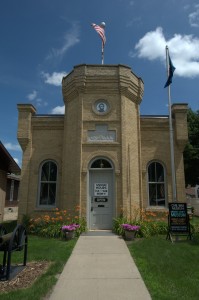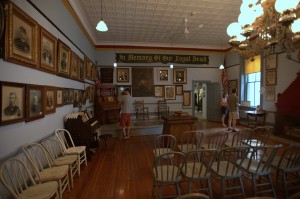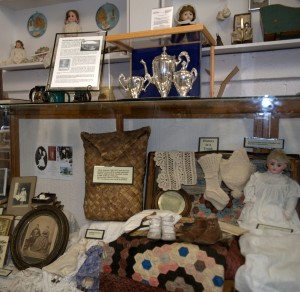
Few casual visitors to the Twin Cities will find their way to Litchfield, Minnesota, 65 miles to the northwest. But this lovely town on the prairie’s edge preserves much that’s important in the superbly restored GAR Hall and, behind it, the Meeker County Historical Museum.[1]
You’ll learn a lot about the Union veterans who migrated to Central Minnesota and about life from the 1860s to the 1940s. And, you’ll discover that Garrison Keillor’s ‘Norwegian Bachelor Farmers’ were real.
***
‘Waving the bloody shirt’: it wasn’t until recently I realised its connection to the corroded, five-point stars embossed ‘G.A.R.’ on Union veterans’ graves.
In his fine history of the 1876 election Roy Morris, Jr describes the phrase’s origin.:
Ever since the day in 1868 when Massachusetts Congressman Benjamin F. Butler had flourished on the floor of Congress the torn and blood-stained shirt of a federal tax collector whipped by the Ku Klux Klan in Mississippi, the bloody shirt had become the Republican Party’s most effective propaganda weapon.[2]
The ‘bloody shirt’ symbolized the South’s continuing resistance to the Union’s social, economic and military victory in 1865. A slogan from the 1876 election summed up the Republican North’s response: ‘Vote as you shot!’[3]
Until my generation, America was known as ‘a nation of joiners’, something de Tocqueville was not the first to note. Union veterans were no exception.
Founded less than a year after the war’s end, the Grand Army of the Republic quickly became the most important of the Union organisations and its posts a key to Republican success.
Of the seven men inaugurated from 1869 through 1901, the six Republicans included five Union generals, of whom four saw combat, and a field-promoted major. The sole Democrat, Grover Cleveland, legally bought his way out of serving the North. ‘The solidly Democratic South’ remained so until the reaction to Civil Rights and social change brought Richard Nixon and the Republican Ascendency.
***
Apart from Civil War memorials and grave markers, the GAR has disappeared. Its membership was limited to Union veterans, the last of whom died in the 1950s.

Litchfield’s Frank Daggett Post #35 is unique in my experience. It holds much to linger over: From the photos of its members – including a freed slave – in middle and old age along its north wall to the rows of gray farm chairs – each slightly different from the others – to mementos of the Dakota War of 1862….
Above the stage and altar (the GAR had rituals like the Masons’), those seated see, ‘In Memory of Our Loyal Dead’. As visitors leave, they pass under ‘We are the Boys of ‘61′.
The phrasing and the placement of the two mottos puzzled me. Why the invocation of the ‘loyal’ – not honored or heroic – dead? Why depart as ‘Boys of ‘61′ rather than men of ‘65?
The more I thought about the mottos and their placement, the more I came back to ‘the bloody shirt’ – the demand for loyalty to the grave, the invocation of the naive idealism of the war’s beginning rather than their experiences of war, Reconstruction and the South’s resurgent politics of race and economics.
The six Union generals the GAR helped elect bring up the bottom of every rating of American presidents. Whatever their failings, during and after the war they had earned the loyalty of their subordinates. Still, they presided over two financial crashes, cratering grain prices and the social dislocation of migration.
How much the men who’d contributed the gray chairs needed the hope of their youths! And, how much more they deserved than what they got!
***
From the relatively spare displays of the GAR Hall, one passes into rooms that look like a huge storage unit into which three generations tossed the debris of everyday life. Kitchen implements, farm tools, optometrists’ gages, hotel mail boxes, old photos….

In the first case on the middle shelf rests a pack made out of strips of wood. It would hold little more than the large laptop I’m using. It had held everything a Swedish teenager emigrating alone brought to Minnesota in the 1890s. The GAR’s members were not the only brave people in the Litchfield of their time.
***
Life on the prairie’s edge in the last third of the nineteenth century rewarded little except hard work and often not that. But Litchfield’s green, the GAR Hall, the handsome churches bespeak the successes against odds of the Civil War generation.
At the back of the museum’s ground floor sits a roofless log cabin. As a boy, the octogenarian who guided us had known the children – second generation Swedish-Americans – who’d grown up in it in the 1890s.
Thinking of ‘A Prairie Home Companion’ and Garrison Keillor’s ‘Norwegian bachelor farmers’, I asked how many children had lived in this room.
Eight, he replied.
Did any marry?
One of the girls did, he answered.

*** About 30 miles west of the Twin Cities, the increasing distance between buildings becomes oppressive to someone from the eastern part of the Old Northwest.
I thought of my childhood mornings listening to Don McNeill’s ‘Breakfast Club’. I could imagine children and mothers all over farm country sharing the laughter. We all wished one day to find our way to the Clouds Room of the Hotel Allerton on Chicago’s Miracle Mile and join the ‘march around the breakfast table’.
Garrison Keillor recognised television hadn’t ended radio’s power to bring people together. More critically, he knew the isolation of the rural life was little different than the loneliness of the suburb or the alienation of the city.
It is not nostalgia Keillor trucks in. It is in a shared recognition of life’s sadness. Like the GAR, ‘A Prairie Home Companion’ raises our spirits with rituals and fun and community. ‘We are the boys of ‘61′ in that light seems much less a waving of the bloody shirt than a great motto for ending an evening with friends.
Notes
1. H/T: Mark Weinberger, Minnesota Off the Beaten Path for its tip on Litchfield, although I would say it underrates the town’s attractions.
2. Roy Morris, Jr., Fraud of the Century [2003] (New York: Simon & Schuster, 2004), p. 11. A superb history of the 1876 election whose unraveling prefigured Bush v. Gore (2000).
3. Id., pp. 3-4.
Recent Comments